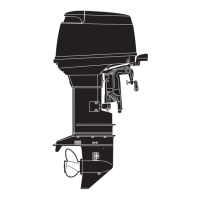
 Loading...
Loading...
Do you have a question about the TOHATSU MX 50D2 and is the answer not in the manual?
| Engine Type | 2-Stroke |
|---|---|
| Starting | Manual |
| Gear Ratio | 2.08:1 |
| Fuel Type | Gasoline |
| Oil Type | 2-stroke engine oil |
| Shaft Length | 15 inches |
Explains DANGER, WARNING, CAUTION, and Note indicators for critical information.
Details the emergency stop switch function and general safe boat operation practices.
Outlines recommendations for authorized service, owner maintenance duties, and proper motor mounting.
Instructions for positioning and securing the outboard motor to the boat transom.
Guidance on choosing a propeller for optimal engine performance at wide open throttle.
Specifies the type of unleaded gasoline required for optimal engine performance and longevity.
Details the type of two-stroke engine oil and fuel-to-oil mixing ratios for operation and break-in.
Outlines the necessary steps for breaking in a new outboard motor for proper component seating and longevity.
Procedures for safely starting the engine and warming it up to operating temperature.
Covers forward/reverse engagement, shallow water running, and mooring procedures.
Proper engine stopping methods and how to adjust the trim angle for optimal boat handling.
Steps required to safely detach the outboard motor from the boat for transport or storage.
Guidelines for safely transporting and storing the outboard motor, including preparation steps.
How to adjust the trim tab to balance steering loads for straight running.
Adjusting the steering resistance for comfortable and safe operation.
Adjusting the friction on the throttle grip for smooth control and preventing accidental movement.
Daily checks to perform before and after using the outboard motor for safety and performance.
Covers washing the motor, and replacing propellers and spark plugs.
Outlines periodic servicing, anode inspection, gear oil change, cleaning, storage, and pre-season checks.
Procedures for checks after impact, engine submersion, and precautions for cold weather operation.